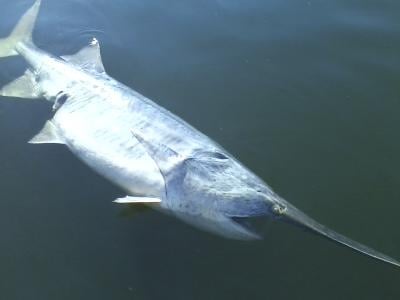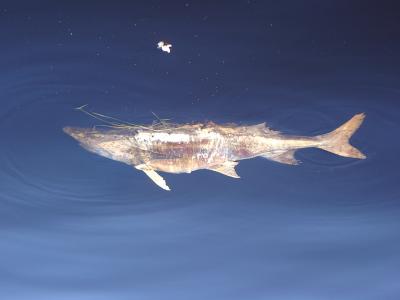Came across this giant paddle fish (floating dead) just north of the old swing bridge. 60+ inches long

September 8, 2013 at 1:59 pm
#1229111
IDO » Forums » Fishing Forums » Wisconsin Lake & Rivers » St. Croix River » St. croix river monster
Came across this giant paddle fish (floating dead) just north of the old swing bridge. 60+ inches long

Still haven’t hooked into one of them yet and that is a big fish
We pointed it out to the DNR creel survey guy and he was really impressed.
Matts Lucky Bait posted a pic on FB of a dead paddle fish floating a week or so ago on the Croix. I wonder what’s killing them ???
How big do these fish get? Could it just be natural causes? Either way that thing is a monster indeed. Cool pic
Zeebs eating all their plankton. I was under the impression that the paddlefish population upstream from Iowa was not that big.
They’re coming back Pug.
Three years ago on the 4th of July, it was like fire works coming out of the water with all the paddles cartwheeling in the are. It was awesome to see.
I EDIT: can’t discount the construction hurting these fish, but over the years I don’t recall ever seeing one that looked like it died of natural causes.
The all had prop marks/cuts on them.
I know the commercial fishermen on P4 (well the ones I know anyway) will move their nets if they start catching paddles and it happens frequently.
That’s cool. So they actually jump? I suppose when a paddle fish jumps, its pretty easy to distinguish from other fish.
Nice to hear they are making a come back. I might have to set up a brine shrimp bait tank.
It’s more of a cartwheel and well out of the water. They are an amazing fish.
They must have been thick in ’09 below L&D #3.
My boat caught (snagged) two while cat fishing. This first on was brought to the boat by Jeff Harcey and tipped the scale at 35 pounds.

(pooped all over Jeff’s son Tanner!)
Two nights later when I was alone I brought one to the boat that was guestimated at over 50 pounds. Hard to tell for sure. It wouldn’t fit into my over sized net and I released it at boat side.
Anytime someone anchored and fishing for cats brings two paddles to the boat you know there must be a ton of fish in that area!
My guess is they swim along and run into the line, the line tightens up on them and when it gets to the hook, finally snags them. Vertical jigging walleye guys get them frequently, but they’re moving and bouncing a jig up and down. Much easier to snag pretty much everything.
I’ve heard guys catch them jigging silver blade baits at the Red Wing damn. Big ones too.
Quote:
I’ve heard guys catch them jigging silver blade baits at the Red Wing damn. Big ones too.
Yea, “catching” on blade baits… 
Catch them on the bill.
I remember seeing a show on them trying to farm them or breed them for reintroduction places. It was cool seeing the underwater video of them suspended with their mouths gaping open.
Quote:
I’ve heard guys catch them jigging silver blade baits at the Red Wing damn. Big ones too.
As Mike alluded to, the blades don’t need to be silver.
Here’s a snagged paddle from P-4. Photo courtesy of Everts Fishing Resort and Tuck.

What a Shame seeing these fish dead it just stinks ….  ….. literately
….. literately

The original fish was 60″? So that one probably died of old age?
Here is a dead one from May 2013. Notice no nose?! I have seen a dead one on shore about every three years or so.

They look like a shark normally. They really do without the nose. Did you investigate it further? Did it look like someone harvested the bill for some f’ed up reason or do you suppose they rot off pretty quick when they die?
Quote:
rot off pretty quick when they die
They come off quickly when a prop from a boat or tow hits them as well.
Thought this was interesting – Taken from Wikipedia
Habitat destruction is also causing their numbers to decrease more rapidly.
Paddlefish need free-flowing rivers that have shallow pools with sandy, rocky bottoms for their spawning.
Water temperature is also important for spawning.
Modification of rivers by the construction of dams, dredging, and water removal for agricultural use reduces paddlefish spawning grounds.
Paddlefish were at one time very abundant in most central U.S. river systems, but populations have declined greatly due to overharvesting, sedimentation, and river modification.
One of the major reasons for declining paddlefish numbers are the dams constructed on many major U.S. river systems.
Paddlefish avoid fish ladders because of the metal rebar used in construction, which disrupts their electro-magnetic sense organs.
The dams block paddlefish migration routes that are very important to the fish for spawning.
From the MN DNR website:
Conservation / Management
Construction of dams and flood impoundment structures on large rivers has eliminated much of the paddlefish’s spawning grounds and interfered with migration. Dredging, overfishing, and pollution have also been implicated in the species’ decline since the start of the 20th Century. Some river construction projects have helped paddlefish populations temporarily, but the long-term effects have been negative (Sparrowe 1986; Unkenholz 1986). Injuries and death from propeller strikes on pleasure crafts in Lake Pepin are increasing and pose a significant threat to the slowly recovering paddlefish population. Additionally, paddlefish can be heavily parasitized by lampreys, which can weaken the fish and cause death (J. T. Hatch, University of Minnesota, pers. comm.).
Zigler et al. (2003) concluded that general area types (for example, channels, tailwaters, or impoundments) based on gross geomorphological features may be inadequate for describing paddlefish habitat and therefore making management recommendations. Rather, microhabitat characteristics (depth, current velocity, and water temperature) appear to be more important factors in habitat selection by paddlefish. The ability of paddlefish to pass through dams and move freely between spawning and non-spawning habitats will be critical for their population recovery. Zigler et al. (2004) found that strong flood pulse (high discharge), low dam head (0.3 m; 12 in. or less), and reduced current velocities positively influenced paddlefish passage through navigation dams in the upper Mississippi River. To effectively manage for this rare species, additional research on paddlefish reproductive and recruitment success is needed. Locating specific spawning areas and evaluating lock chambers as possible avenues for fish passage of navigation dams will be important components of any future studies.
Other common names for the paddlefish include spoonbill cat, duckbill cat, boneless cat, and spadefish.
I saw Andrew Zimmern the other night catch one for eating. I don’t recall where they were but there was a minimum size, the fishery was planted and they were snagging.
Just found it. St Louis.
http://www.travelchannel.com/tv-shows/bizarre-foods/episodes/st-louis-pig-snouts-and-paddlefish
You must be logged in to reply to this topic.